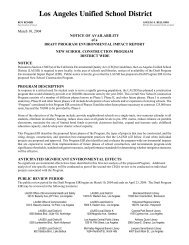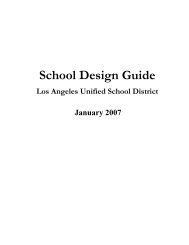Site-Specific Health and Safety Plan (HASP) - Laschools.org
Site-Specific Health and Safety Plan (HASP) - Laschools.org
Site-Specific Health and Safety Plan (HASP) - Laschools.org
Create successful ePaper yourself
Turn your PDF publications into a flip-book with our unique Google optimized e-Paper software.
LAUSD Proposed South Region High School #9 & Middle School #4<br />
4-5<br />
December 2006<br />
<strong>Site</strong> <strong>Specific</strong> <strong>Health</strong> & <strong>Safety</strong> <strong>Plan</strong> (<strong>HASP</strong>)<br />
• All field crew members should make use of all of their senses to alert themselves<br />
to potentially dangerous situations to avoid (e.g., presence of strong <strong>and</strong> irritating<br />
or nauseating odors).<br />
• Personnel will practice unfamiliar operations prior to performing them in the<br />
field.<br />
• Field crew members will be familiar with the physical characteristics of<br />
investigations <strong>and</strong> field demonstrations, including:<br />
− Wind direction in relation to contamination zones;<br />
− Accessibility to co-workers, equipment, vehicles <strong>and</strong> communication devices;<br />
− Communication signals <strong>and</strong> devices;<br />
− Hot zone locations (areas of known or suspected contamination);<br />
− <strong>Site</strong> access; <strong>and</strong><br />
− Nearest water sources.<br />
• Personnel <strong>and</strong> equipment in the designated work area should be minimized, consistent<br />
with effective site operations.<br />
The discovery of any condition that would suggest the existence of a situation more hazardous<br />
than anticipated will result in the reevaluation of the hazard <strong>and</strong> the level of protection required,<br />
<strong>and</strong> may result in a temporary evacuation of the field team from the immediate work area. Such<br />
conditions may include an adverse effect or symptom of exposure experienced by a field team<br />
member, or the excess of the action levels for <strong>org</strong>anic vapors <strong>and</strong>/or combustible vapors. If the<br />
action levels for <strong>org</strong>anic vapors <strong>and</strong>/or combustibles are exceeded, procedures will be followed<br />
as stated in Section 10 of this health <strong>and</strong> safety plan.<br />
In the event that local Parsons management is not available during an emergency such as an<br />
injury to Parsons employees or contractor personnel, damage to facilities or operations, or threats<br />
against personnel or operations, Parsons personnel will contact the Parsons Emergency Contact<br />
Service. This hotline provides live telephone call support in English <strong>and</strong> Spanish 24-hours a day,<br />
7 days a week, <strong>and</strong> 365 days a year for immediate guidance <strong>and</strong> response when local<br />
management is not available. The telephone number for this service is located along with the<br />
other emergency numbers in Attachment 1.<br />
4.9 INCIDENT INVESTIGATIONS<br />
All incidents <strong>and</strong> significant near-miss incidents are investigated by an individual or team with<br />
training in accident investigation <strong>and</strong> root cause analysis. Subcontractors (if applicable) must<br />
investigate incidents involving their employees or activities <strong>and</strong> submit an investigation report to<br />
the Parsons Project Manager within 48 hours of an incident.<br />
In Parsons, the GBU <strong>Safety</strong> Manager investigates or assigns an investigator to each significant<br />
incident. The investigator submits a final investigation report using the online safety reporting<br />
system within 72 hours of the incident. The Project <strong>Safety</strong> Manager maintains the investigation<br />
file.<br />
176







